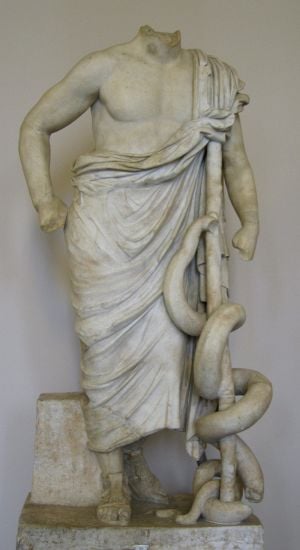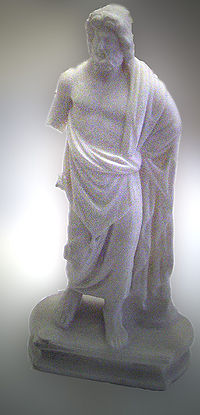Asclepius
Template:Greek myth (other gods)
Asclepius (Greek Άσκληπιός, transliterated Asklēpiós; Latin Aesculapius) was the demigod of medicine and healing in ancient Greek mythology. Asclepius represents the healing aspect of the medical arts, while his daughters Hygieia, Meditrina, Iaso, Aceso, Aglæa/Ægle and Panacea (literally, "all-healing") symbolize the forces of cleanliness, medicine and healing, respectively.
Mythology

Asclepius was married to Epione, with whom he had six daughters: Hygieia, Meditrina (the serpent-bearer), Panacea, Aceso, Iaso, and Aglaea, and three sons: Machaon, Telesphoros, and Podalirius. He also bore a son, Aratus, with Aristodama.
Coronis (or Arsinoe) became pregnant with Asclepius by Apollo but fell in love with Ischys, son of Elatus. A crow informed Apollo of the affair and he sent his sister, Artemis, to kill Coronis. Her body was burned on a funeral pyre, staining the white feathers of the crows permanently black. Apollo rescued the baby by performing the first caesarean section and gave it to the centaur Chiron to raise. Enraged by his grief, Coronis' father Phlegyas torched the Apollonian temple at Delphi, for which Apollo promptly killed him.
Chiron taught Asclepius the art of surgery, teaching him to be the most well-respected doctor of his day. According to the Pythian Odes of Pindar, Chiron also taught him the use of drugs, incantations and love potions. In The Library, Apollodorus claimed that Athena gave him a vial of blood from the Gorgons. Gorgon blood had magical properties: if taken from the left side of the Gorgon, it was a fatal poison; from the right side, the blood was capable of bringing the dead back to life. According to some, Asclepius fought alongside the Achaeans in the Trojan War, and cured Philoctetes of his famous snake bite. However, others have attributed this to either Machaon or Podalirius, Asclepius' sons, who Homer mentions repeatedly in his Iliad as talented healers. Asclepius, on the other hand, is only referred to in Homer in relation to Machaon and Podalirius.
Asclepius' powers were not appreciated by all, and his ability to revive the dead soon drew the ire of Zeus, who struck him down with a thunderbolt. According to some, Zeus was angered, specifically, by Asclepius' acceptance of money in exchange for resurrection. Others say that Zeus killed Asclepius after he agreed to resurrect Hippolytus at the behest of Artemis. Zeus may or may not have smitten Hippolytus with the same bolt. Either way, Asclepius' death at the hands of Zeus illustrates man's inability to challenge the natural order that separates mortal men from the gods.
In retaliation for Asclepius' murder at the hands of Zeus, Apollo killed the Cyclopes, who fashioned Zeus' thunderbolts. According to Euripides' play Alkestis, Apollo was then forced into the servitude of Admetus for nine years.
After he realized Asclepius' importance to the world of men, Zeus placed him in the sky as the constellation Ophiuchus. The name, "serpent-bearer," refers to the Rod of Asclepius, which was entwined with a single serpent. This symbol has now become a symbol for physicians across the globe. However, one should be careful not to confuse the Staff of Asclepius, which features a single serpent wrapped around a roughhewn branch, with the Caduceus of Mercury (Roman), or the Karykeion of Hermes. The Caduceus, which features two intertwined serpents (rather than the single serpent in Asclepius' wand), as well as a pair of wings, has long been a symbol of commerce. It is thought that the two were first confused in the seventh century C.E., when alchemists often used the caduceus to symbolize their association with magical or "hermetic" arts.
The Greeks used the name Asclepius interchangeably with the then well known Egyptian genius Imhotep.
Cult
Asclepius' most famous sanctuary was in Epidaurus in Northeastern Peloponnese. Another famous "asclepieion" was on the island of Kos, where Hippocrates, the legendary doctor, may have begun his career. Other asclepieions were situated in Trikala, Gortys (in Arcadia), and Pergamum in Asia.
In honor of Asclepius, snakes were often used in healing rituals. Non-venomous snakes were left to crawl on the floor in dormitories where the sick and injured slept. Starting about 300 B.C.E., the cult of Asclepius grew very popular. His healing temples were called asclepieion; pilgrims flocked to them to be healed. They slept overnight and reported their dreams to a priest the following day. He prescribed a cure, often a visit to the baths or a gymnasium.
It is also written by Lewis Farnell, that some healing temples used sacred dogs to lick the wounds of the sick petitioners. 1
The original, ancient Hippocratic Oath begins with the invocation "I swear | by Apollo the Physician and by Asclepius and by Hygieia and Panacea and by all the gods . . ." Scholars have written that this oath may not have been written by Hippocrates, but by or with others in his school, or followers of Pythagoras. 2
Some later religious movements claimed links to Asclepius. In the 2nd Century AD The False Prophet Alexander claimed that his god Glycon was an incarnation of Asclepius.
The botanical genus Asclepias (commonly known as milkweed), is named after him, and includes the medicinal plant A. tuberosa or "Pleurisy root".
Etymology
The etymology of the name is unknown. In his revised version of Frisk's Griechisches etymologisches Wörterbuch, R.S.P. Beekes gives this summary of the different attempts:[1]
- "H. Grégoire (with R. Goossens and M. Mathieu) in Asklépios, Apollon Smintheus et Rudra 1949 (Mém. Acad. Roy. de Belgique. Cl. d. lettres. 2. sér. 45), explains the name as 'the mole-hero', connecting σκάλοψ, ἀσπάλαξ 'mole' and refers to the resemblance of the Tholos in Epidauros and the building of a mole. (Thus Puhvel, Comp. Mythol. 1987, 135.) But the variants of Asklepios and those of the word for 'mole' do not agree.
- The name is typical for Pre-Greek words; apart from minor variations (β for π, αλ(α) for λα) we find α/αι (a well known variation; Fur. 335 - 339) followed by -γλαπ- or -σκλαπ-/-σχλαπ/β-, i.e. a voiced velar (without -σ-) or a voiceless velar (or an aspirated one: we know that there was no distinction between the three in the substr. language) with a -σ-. I think that the -σ- renders an original affricate, which (prob. as δ) was lost before the -γ- (in Greek the group -σγ- is rare, and certainly before another consonant); Beekes Pre-Greek.
- Szemerényi's etymology (JHS 94, 1974, 155) from Hitt. assula(a)- 'well-being' and piya- 'give' cannot be correct, as it does not explain the velar."
One might add that even though Szemerényi's etymology (Hitt. asula- + piya-) does not account for the velar, it is perhaps inserted spontaneously in Greek due to the fact that the cluster -sl- was uncommon in Greek: so, *Aslāpios would become *Asklāpios automatically.
Popular Culture
In Robert Graves' historical novel, Hercules, My Shipmate, Asclepius was an ordinary mortal who accidentally resuscitated a drowned boy by moving his limbs in imitation of life's activities. This enraged the priestesses of Hecate, and they promptly killed him when he refused to stop such unnatural activities.
In the Trauma Center video games, those gifted with the Healing Touch (the ability to induce superhuman concentration and appear to slow time or improve the patient's vitals while preforming well in the operation allowing the player to perform miracle surgeries) are said to be "descended from Asclepius." One of the chapter names is called "Striving for Asclepius."
In the Japanese graphic novel Get Backers one of the main characters Ban Mido uses the power of the card Asclepius in the Divine design saga of the story. This version of Asclepius uses the evil eye, an illusion conjuring power and an attack called snake bite that uses the strength of a snakes jaw to crush his opponents.
Footnotes
1 cf. L.R. Farnell, Greek Hero Cults and Ideas of Immortality, Chapter 10, "The Cult of Asklepios" (pp.234-279), p.240
2 cf. L.R. Farnell, Greek Hero Cults and Ideas of Immortality, Chapter 10, "The Cult of Asklepios" (pp.234-279), p.269: "The famous Hippocratean oath may not be an authentic deliverance of the great master, but is an ancient formula current in his school."
ReferencesISBN links support NWE through referral fees
- Lewis Richard Farnell, Greek Hero Cults and Ideas of Immortality, 1921.
See also
- Rod of Asclepius
Credits
New World Encyclopedia writers and editors rewrote and completed the Wikipedia article in accordance with New World Encyclopedia standards. This article abides by terms of the Creative Commons CC-by-sa 3.0 License (CC-by-sa), which may be used and disseminated with proper attribution. Credit is due under the terms of this license that can reference both the New World Encyclopedia contributors and the selfless volunteer contributors of the Wikimedia Foundation. To cite this article click here for a list of acceptable citing formats.The history of earlier contributions by wikipedians is accessible to researchers here:
The history of this article since it was imported to New World Encyclopedia:
Note: Some restrictions may apply to use of individual images which are separately licensed.

